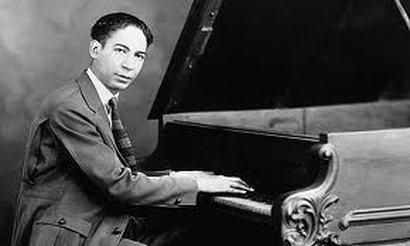 Jelly Roll Morton: Born 1890; Died 1941. Musical Selection: “King Porter”, “Jungle Blues”, “Black Bottom Stomp” For many years there was confusion over Morton’s date of birth: 1889 on his death certificate while other commentators pushed for 1885. The precise facts were established by Lawrence Gushee. He also found that Morton, born Ferdinand LaMenthe (the family name was LaMothe and he was baptized Lemott) in New Orleans, took the name Morton from a stepfather (who’s name was actually Mouton!) Morton started out on guitar as a boy before switching to piano in early adolescence. He claims to have been playing Storyville bordellos in 1902, though a date closer to the middle of the decade is more realistic; here he met and learned much from pianist Tony Jackson before moving on to other parts of Louisiana and Mississippi. Between 1906 and 1908 he traveled from Florida to California as well as Chicago, St Louis, and Houston, making money as a hustler, pool shark, part-time pimp, and all-round con man as well as learning much from the pianists he encountered, including the legendary “Jack The Bear.” In 1909 he worked in a Memphis theater, then joined a vaudeville team eventually making it to New York. Morton spent time in Chicago, running his own band in 1914-15, then pushed on to LA, where he met Anita Gonzales, later his wife, and more than once made it as far as Mexico. In 1923 Morton moved to Chicago, attracted by a booming music business there and the chance of recordings and piano rolls. That year he debuted on both recording media, also finding work with the Melrose publishing company and running his sometime band, the Rid Hot Peppers. In 1926 Morton began making the series of 78s for the Victor Company, which were to seal his jazz reputation. These were with his studio band, the sometimes septet/octet, the Red Hot Peppers, a band often featuring clarinetist Omer Simeon, trumpeter George Mitchell and trombonist Kid Ory. The style was New Orleans, but very much Morton’s own idea of New Orleans: in fact, his arrangements, allied to his humor and compositions, made for a vivid portrayal of the hybrid form of jazz. Pieces like “The Pearls,” “King Porter,” “Jungle Blues,” “Black Bottom Stomp,” “Dead Man Blues,” “Sidewalk Blues,” and many more all testify to his unique abilities. Compared with contemporaneous dance arrangements and tunes in 1926-28, Morton was streets ahead. Unfortunately, he alienated many people who could have helped, including the MCA booking agency. A Move to New York in 1928 presaged his eclipse. Morton wanted no part of the emerging big-band movement. In 1930 his Victor contract was not renewed. Down on his luck he made one Wingy Manone session in 1934 before moving to Washington, DC, once more leaving music for a period. Working as a pianist in a lowlife Washington club, Morton was approached by folklorist Alan Lomax to make a series of recordings for the Library of Congress in late summer 1938. The resulting records are one of the greatest first-hand archives of New Orleans testimony in existence. In between sessions, however, he was stabbed in a brawl at his club, triggering a round of ill health. A move back to New York in 1938 and radio appearances in the Big Apple let to Morton recording with Sidney Bechet and Albert Nichoas, making a fine session for Bluebird. Morton mad further records for General, piano solos, and group recordings, which show him to be in complete command of his abilities. If he had lived, he would undoubtedly have become a focal point for the 1940s revivalist. His deteriorating health was exacerbated by a cross-country winter drive 1940-41, and by the summer of 1941 Morton was dead.
1 Comment
1/27/2012 04:26:26 am
Jelly roll's music and humor was awesome. We played King Porter Stomp in my college Jazz band (I was the guitarist). It was definitely one of my favorite jazz band pieces I've ever played. Thanks for the info, that's sad that he's career came to an end because he got stabbed.
Reply
Leave a Reply. |
Jazz LegendsA blog on the great legends in Jazz. Information via "The Encyclopedia of Jazz and Blues". Archives
December 2017
Categories |
 RSS Feed
RSS Feed

